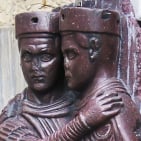Two dummy questions about Unicode

mauro sacchetto
Posts: 353
Two little curiosities about what makes up the Unicode standard.
1) Why are there glyphs like <o + tilde + acute>, but not <o + tilde + grave>? True that. if necessary, you can create and insert maybe in the PUA or leave them unmapped, but I don't understand if there are linguistic, graphic or other reasons that determine the presence of some composite glyphs and other ones not.
2) In the case of mapped glyphs, there is the possibility to call them by name (Abrevedotbelw) or simply indicate them with the code (uni1EB6). Are the two modes completely equivalent or is it preferable to choose one?
0
Comments
-
1. Unicode favours using sequences of base letters plus combining mark characters to encode diacritics, but also inherited a substantial set of precomposed diacritics from earlier character sets with which Unicode promised one-to-one mapping. This is why some but not all diacritics are encoded with precomposed characters. These precomposed characters have canonical decompositions to combinations of base + combining mark(s), and some text processes will decompose the precomposed diacritics, e.g. for search, sort and compare functions. Because Unicode has stability agreements with other standards, no new precomposed diacritics with canonical decompositions can be added to Unicode.
2. This refers to glyph naming in fonts, rather than to Unicode per se. Glyphs in fonts can have arbitrary names (which may or may not be parseable by software), standardised or rule based names (intended to be parseable by software), or no names at all (e.g. TTF with format 3 post table). The commonest set of standardised and rule based names is based on Adobe's system, which can be parsed by Acrobat to recreate text content strings in PDFs that have been distilled from print streams, so that such PDFs can be searched. These names must either be included in the Adobe Glyph List or derived from a set of rules that Adobe specified for Unicode characters, variant glyphs, and ligatures. The uniXXXX and uXXXXX format names are part of this specification. Often, the names used in development by the font maker might differ from the names output to the font file when it is generated. So, for example, a font maker might use a human-friendly development name such as /dKa/ or /kadeva/ for the Devanagari letter Ka character, but the parseable name written to the font file would be /uni0915/.7 -
Ok, I come back to default. Thank you0
Categories
- All Categories
- 46 Introductions
- 3.9K Typeface Design
- 487 Type Design Critiques
- 563 Type Design Software
- 1.1K Type Design Technique & Theory
- 655 Type Business
- 859 Font Technology
- 29 Punchcutting
- 520 Typography
- 119 Type Education
- 324 Type History
- 77 Type Resources
- 112 Lettering and Calligraphy
- 33 Lettering Critiques
- 79 Lettering Technique & Theory
- 558 Announcements
- 94 Events
- 114 Job Postings
- 170 Type Releases
- 179 Miscellaneous News
- 276 About TypeDrawers
- 54 TypeDrawers Announcements
- 120 Suggestions and Bug Reports
